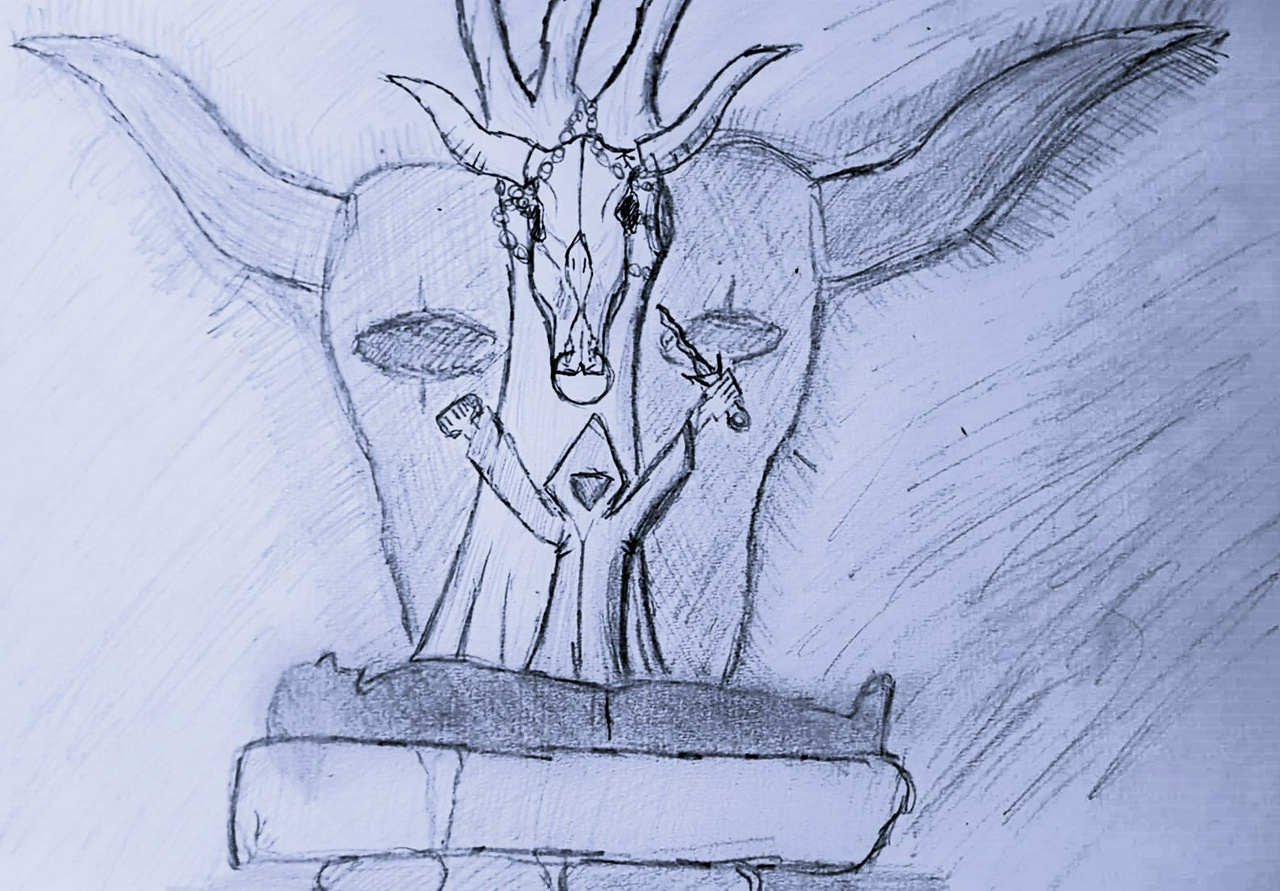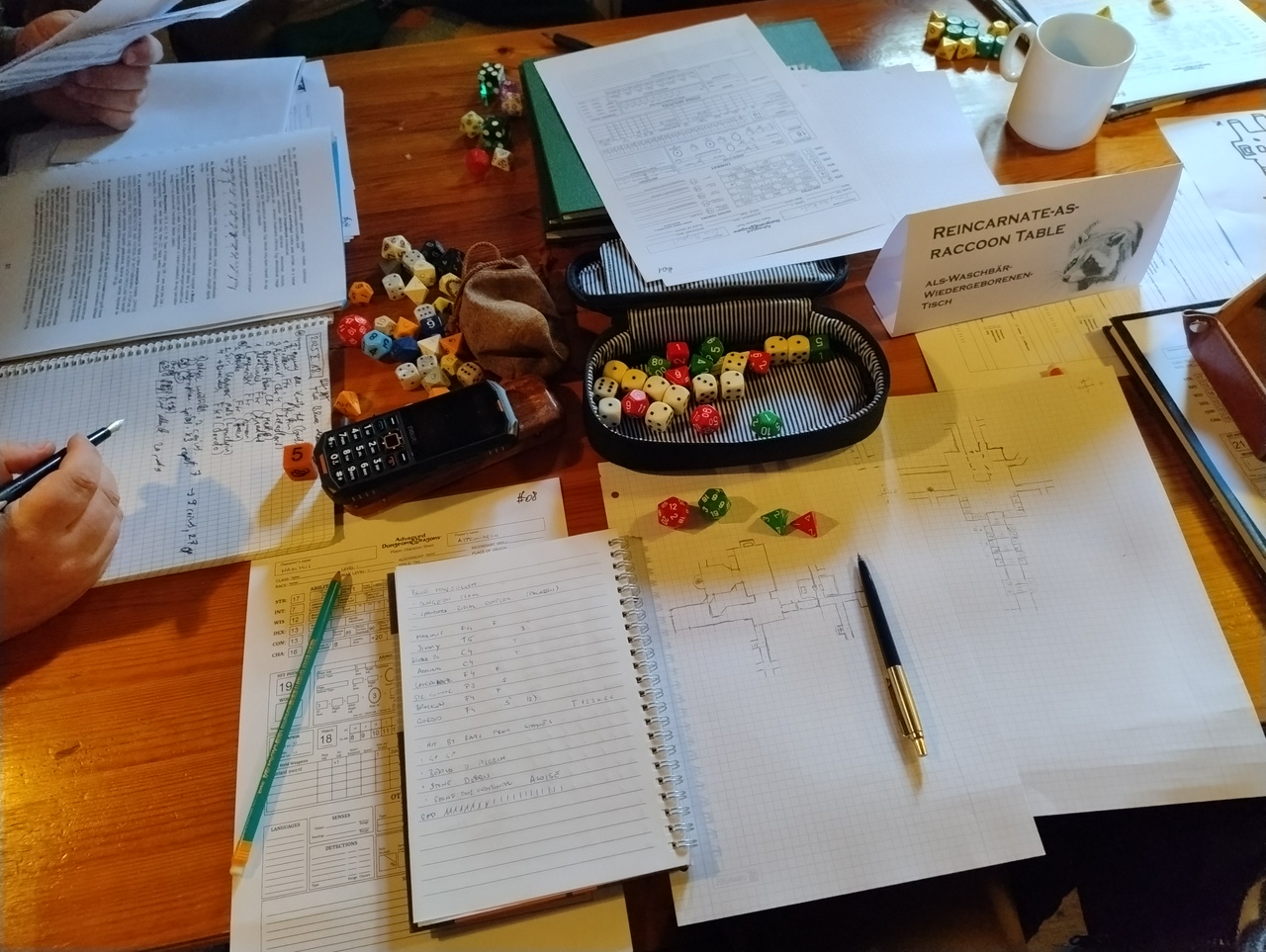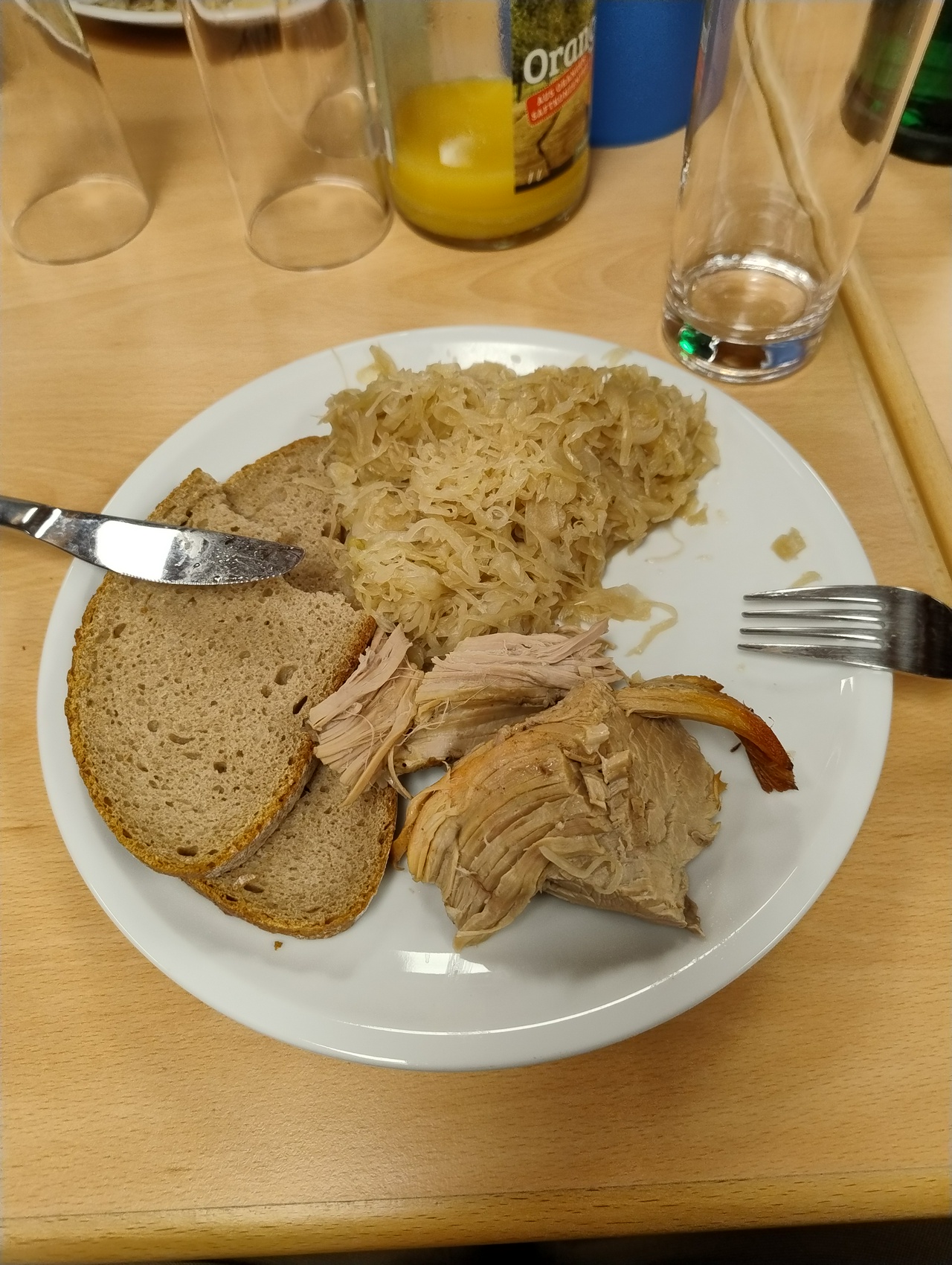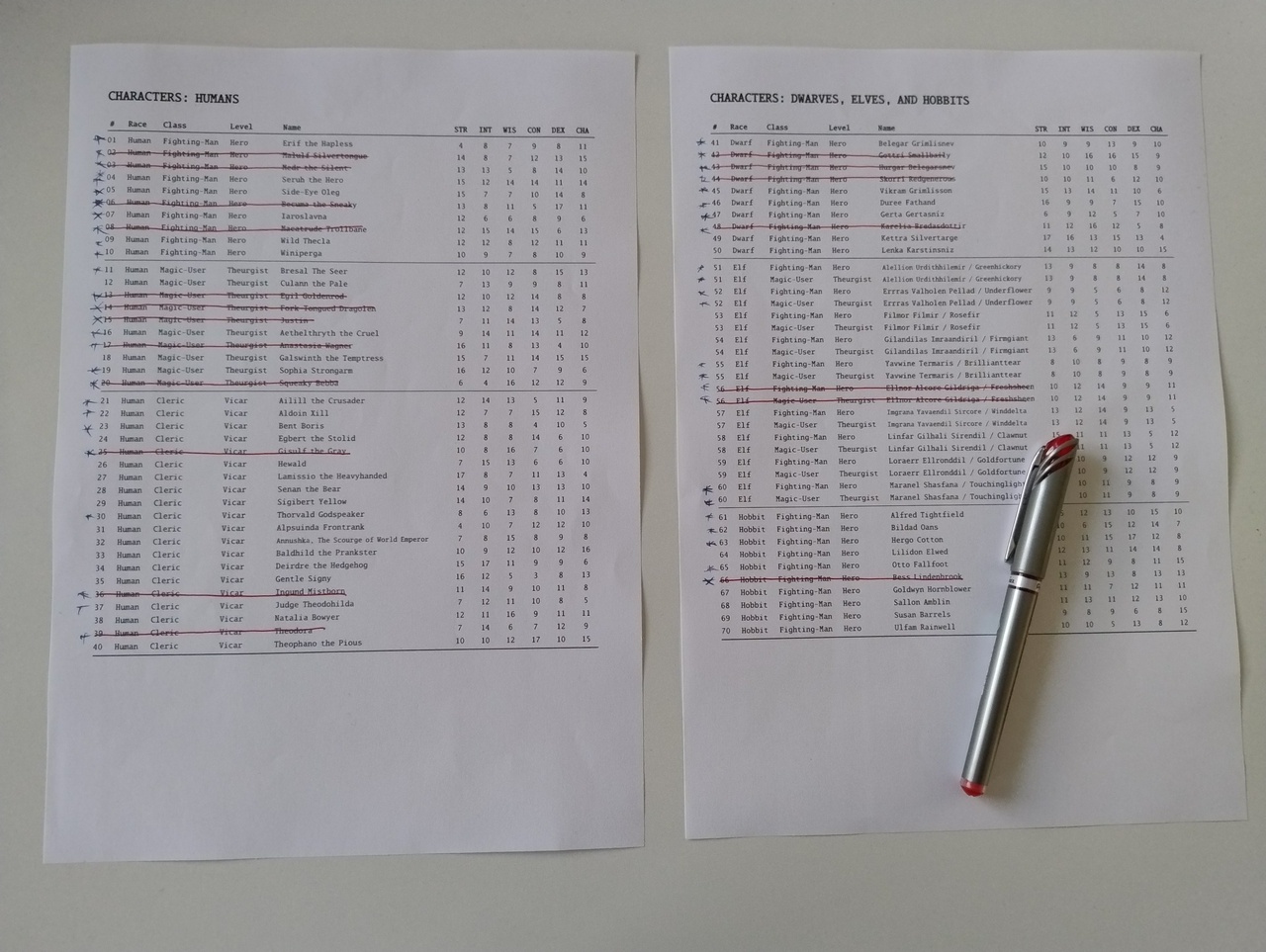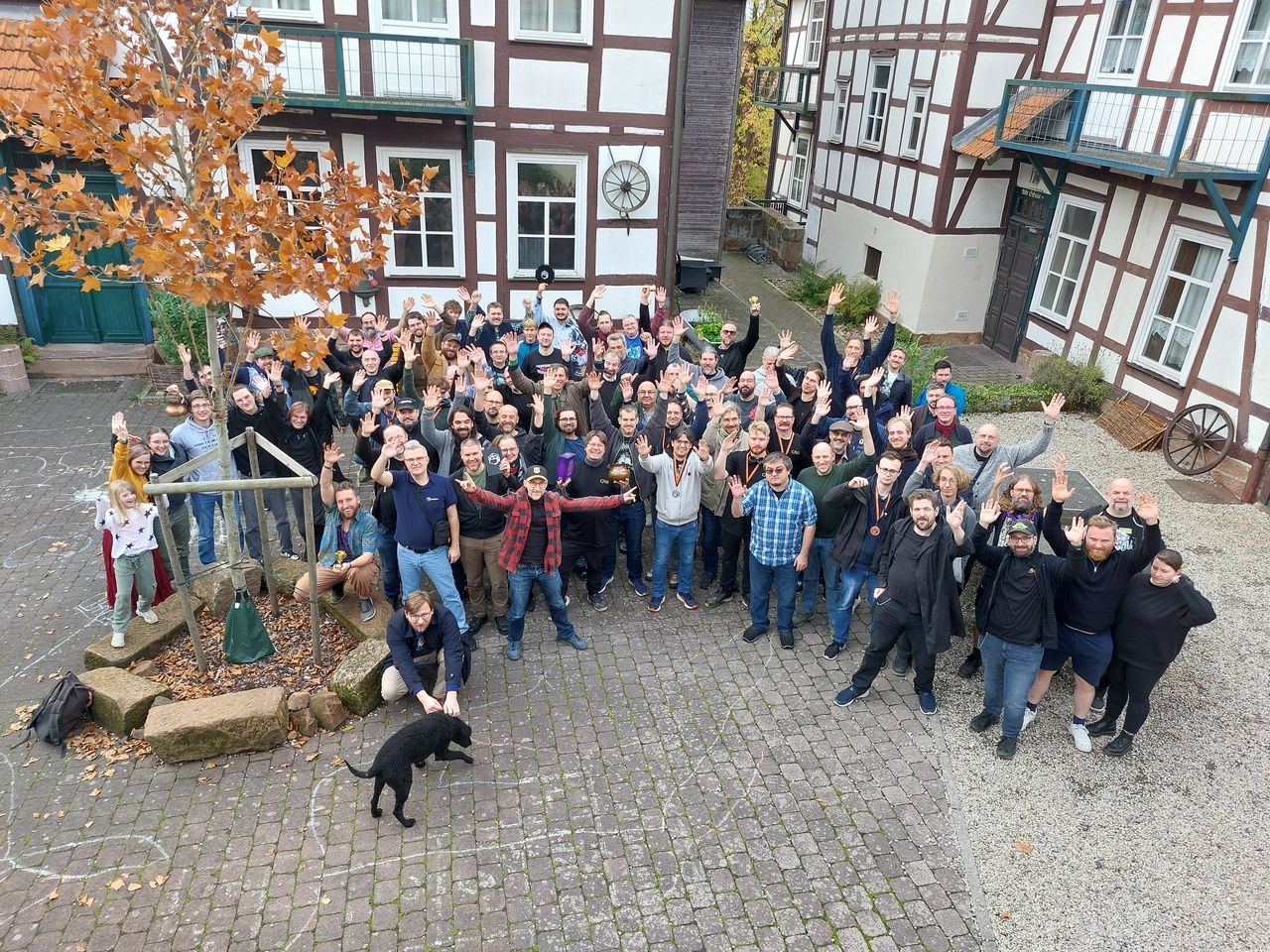I spent last weekend (October 17–19) playing old-school Dungeons & Dragons at Cauldron, “an OSR Euro Con.” I had an absolute blast of a time, organisers did an amazing job, and players were all great.
In this post I share reports for all games I either ran or played in:
You can read more on my preparation for the con here, and my reflection on the whole con here.
Friday games
Friday Block I Temple of Doom Sidekick: Coliseum of the Lunar Lion
Five hours to get in and retrieve a stolen scroll before magical defenses and guards reactivate. Protective systems are driven by lunar power. In total we were eight player characters, myself playing Gorath Zult.
We opened by invading the titular coliseum, where we slaughtered mounted knight and six berserkers shooting at us from elevated platforms. The former provided us with a magic long sword. From there we barreled through room after room with suspicious looking items, frequently interacting with them in disrespectful manner.
 |
| Colliseum massacre. |
Gorath broke evil statue of a horse, which netted him a ghostly stallion. Not to ride, but to be ridden by. It galloped right through the him. After few more turns of wandering around, our Magic-User cast Locate Object from the scroll, giving us a rough direction to go in.
From then on we constantly pushed in that direction, triggering few traps along the way. One of them was a concave floor that caved in as soon as Gorath stepped on it. Luckily for him, he did so just as he heard trot of a galloping horse—ethereal stallion charged but missed him since he was in a freefall.
Some foul mud elemental came out of water, but ultimately did nothing to our invincible party. We eventually burst into a vile dark chamber where skeletal figure cackles and teleports 6 out of 8 characters. Gorath rushes back, as do others. Skeletal figure is immune to everything but magical weapons, which only Gorath has. A quick decision is made as time tickles.
The cleric grapples vile undead while Gorath beats down on it with a magical sword. Others keep exploring, triggering more traps and mischief. Gorath and cleric take some time do destroy the undead.
In his final moments, Gorath runs after the party, past a horde of undead and into the chamber where thief, ranger, and dwarf fighter have found the scroll. Dwarf turns on the party, Gorath knocks him unconscious, and tries to drag him out, but is slain by an imp.
Friday Block II: The Thieves of Fortress Badabaskor
A party of eight champions of Law were recruited to exterminate the Temple of Angall beneath the Fortress Badabaskor. Alphabetically: Becuma the Sneaky, Bess Lindenbrook, Fork-Tongued Dragolen, Gisulf the Gray, Iaroslavna, Justin (as Jagastyr), Medr the Silent, and Squeaky Bebba.
Acting on their intelligence, the party traversed miles long cave and tunnel system, until they emerged in a large cavern. After some prodding and exploring they found a hewn corridor, and followed it. Navigating the corridors they found their way down, and followed the stench of death.
This led them to three zombies guarding battered wooden doors. They cut them down with great ease, broke through the doors, and were promptly blasted by a Wand of Cold. No one was sparred given that they were all in the straight corridor. Becuma, Jagastyr, Gisulf, Dragolen, and Bess were immediately frozen to death. Medr the Silent and Squeaky Bebba were beaten to death by an evil cleric inside the room. Iaroslavna broke her glass bead and teleported away, to safety.
 |
| TPK intermission. |
New Champions of Law were recruited for the same mission, this time ten of them. Iaroslavna was the only returning Hero, providing much needed additional intelligence. Others were Aethelthryth the Cruel, Egil Goldenrod, Erif the Hapless, Gerta Gertasniz, Maranel Shasfana / Touchinglight, Side-Eye Oleg, Sophia Strongarm, Thorvald Godspeaker, and Winniperga.
Armed with Iaroslavna's insight, new party decides to explore the large cave before proceeding deeper into the dungeon. Thus they turn left and follow the cave wall, slowly going upwards. Casting Detect Evil reveals a massive red dragon napping in the gaping mouth of an even bigger dragon. Luckily, the latter is just a stone carving, and not an actual, living and breathing, dragon.
Adventurers freeze in place as the dragon opens it eyes lazily. With some quick thinking, one of the adventurers speaks Orcish, stating that they are nothing but lowly servants here to serve a mighty dragon. Old dragon began coughing violently, claiming to have a really dry throat. His only medicine? Something fatty, like a hobbit or dwarf or pig.
“We shall bring you some pigs!” the adventurers promise as they retreat and follow Iaroslavna's instructions to cut across the cavernous cave and into the hewn corridor.
“A medusa! Or worse!” one of the adventurer's gasps as they find a life-like statue of a dwarf lying on its belly, arms outstretched forward, and head looking behind it, face of mangled terror. With vengeance on their mind, the party descended, turned left, crossed the junction, and stormed the room where their comrades were blasted to death.
Alas! Nothing but shame and horror greeted them! The chamber was completely empty, sans the rotting corpses of adventurers that were slain here month ago. Backtracking to the junction, party decides to follow northern route. Two hundred feet later they experience a joy of losing a character to a pit trap. Undeterred, they moved onwards.
Labyrinthine corridors led them to a junction. Long stairs down were southwards. Dark corridor westwards. Thorvald Godspeaker felt a strong presence of Chaos. This was a foul, foul place. Unsure which route to take, adventurers reasoned that deep evil must be at deep levels. Thus, they went down.
Long descent awarded them with a four way junction. Party elected to explore the east passageway. They went straight for some hundred feet, turned right, and then progressed for another hundred or so feet before they were surprised by a child!
Paranoid and on high alert, they were incredibly suspicious of this little kid appearing in front of them. “Thorvald! Please save us, Thorvald!” the child cried, dropping on her knees. She pleaded and begged, eyes full of tears.
With generous use of ESP and Detect Evil, adventurers surmised that this child was a victim of slavers, captured in the Barbarian Altanis, and taken to the Thieves of Fortress Badabaskor. She knew Thorvald's name because he visited her village months ago.
Champions of Law lived up to their name. They consoled the child, and stormed the chamber behind her. There they found a sad sight best left undescribed. Amongst the remains was another scared child. Maranel and Egil gave up their escape beads and both kids were teleported to safety.
Exploring the chamber revealed a secret sliding doors in the south west corner. Opening them revealed a dark corridor. At the edge of light a young woman stood, asking for help. Once she was Detected as Evil she fled, hissing and laughing, into the darkness. Giving chase, Maranel spotted another secret slider, just to the left. Abandoning the pursuit, adventurers opened the secret doors, seen a three-headed fire-breathing hydra, and promptly closed the doors.
Thorvald did not feel a strong presence of Chaos as before. Therefore, adventurers decided to return upstairs to explore the corridor facing west. This led them to another junction, splitting south and further west. Growling and grunting could be heard from the latter direction.
Brisk fifty feet forward, another pit trap, and a break-in later, the party found themselves facing off against two were-boars and one were-tiger. By all accounts, they just burst in on a heated discussion on how to divide loot. A Charm Person spell later, and boars dismembered the tiger.
Reasoning that gold is better than whatever their victims previously possessed, the adventurers came n possession of Bag of Holding, Mace of Disruption, Bracers of Defence, and Ring of Delusion. Last was taken by Egil, whom immediately began forging megalomaniacal plans.
Were-boars agreed to Egil's plan to raid the Temple of Angall for more treasure and goodly loot, and shared everything they know about what lies further south.
Let it be known that the following were to the south: Priests' Quarters, Sacrificial Room, and Prayer Room. Lycanthropes of course did not know neither the names nor purpose of each room, but from time to time they loitered in each, and were thus able to inform the adventurers broadly about them.
Party decided to follow the Right Hand Path, and thus burst into the Prayer Room. There they surprised six evil Bishops deep in prayer to some weird looking plinths. Without any hesitation they charged the men in prayer, slaying them indiscriminately, Two managed to escape, fleeing south.
There was a copper ring on each plinth. First granted improved saving throws to the wearer. Second sent Egil to eternal slumber. Other adventurers were too busy with pursuit to notice that Egil was down.
Evil Bishops ran south, some eighty or so feet, then turned left and through massive copper doors plated with gold. Adventures chased them through the doors, breaking into the Temple of Angall.
Floor shimmered in white-silver coin—in fact hundreds of thousands of silver pieces were inlaid in the floor—while the ceiling was made of brass with intricate patterns and motifs. A large black diamond dominated the center of the ceiling. Massive altar emanating Chaos Beyond Comprehension rested along the south wall.
Vampires, wraiths, spectres, and flying snakes assaulted the adventurers without mercy. Champions of Law crushed their Beads of Escape, teleporting into safety.
Maranel and Egil were left behind, their fate unknown.
And thus, The Cult of Angall remains a threat to all of Wilderlands.
Saturday games
Saturday Block I: The Blue Mausoleum
A party of eight set upon ancient mausoleum worthy of robbing. We marched in cocky, got blasted by skeletal statues by the entrance, Jimmy the Thief figured out we just need to bribe them, and all was good.
Maximus the Hero was neither the strongest, nor the most dexterous, nor the sturdiest, amongst the adventurers, but he had gumption, determination, and courage aplenty. This is his retelling of the expedition.
“Jimmy the Blade and others roped me in in yet another questionable delve. “We have treasure maps!” they said. But all the hey was a piece of parchment with Carnivorous something and another piece of parchment with some sort of riddle or something. Bah! Anyway, there was this mausoleum, supposedly full of riches.”
“So we go to this massive domed thing, and lo and behold, the entrance is guarded by skeletal statues. There is some hundred or so feet of stairs, with a pair of statues every ten or twenty feet. I don't remember exact measures. But I do remember getting zapped by rays from the statues after passing by them!”
“It was Jimmy the Knave who figured out that you have to bribe the statues. Unbelievable—even the dead desire coin! What for?! Like they can use it. Nonsense. Anyway, the bribe worked well and we were able to descend.”
“We exited in a large chamber, some eighty by hundred or so feet—like I don't know why they keep bringing me along! It surely ain't for brawn, for Sir Connor, Brocken, and Gordo all have mightier thews. Nah, they bring me along because I can scribble quick maps. Yeah. Anyway. While everyone was busy running around, I was busy taking notes.”
“This chamber had a number of egresses. Six corridors, two on each wall except the south one. Then a large hole leading some fifty feet down. And of course the entrance we came through. Anyway, the gang decided it'd be best to rappel down the opening.”

“Chamber beneath it was filled with rubble and remnants of broke statues. Why? What for? Fuck me if I know. Jimmy the Mole eventually found some secret doors leading us to series of tight corridors and burial sites. Gray ooze attempted to surprise is, but we exterminated it so quick it didn't even have time to turn around and flee. Anyway, we backtracked to explore a portion of the mausoleum that looked much older.”
“That proved to be a route most great, for we encountered a creature most disgusting and vile. Some sort of abomination, taking the worst from humans, spiders, and caterpillars. Jimmy the Bait did his job proper, and led the monstrosity to us. We gave it a proper beating. Then we looted its foul lair. Heck yea! Adventuring! Treasure! Wealth! Magic! Anyway, we pushed on and explored stairs leading up.”
“This was helpful, for we identified another way to get out from the second level without having to worry about someone or something destroying all our anchors and ropes. Anyway, we returned to that part of the complex with fancier crypts. And then we barely touched them! Fine, fine, we were hyper focused on finding this Carnivorous something something.”
“We eventually stumbled upon totally insane dwarf preoccupied with his collection of garbage. He tried really hard to explain how this were very valuable historical artefacts and items, but all I could see is broken debris arranged in weird ways. Anyway, he tells us the place we are looking for is south west. So we go there.”
“Now, listen to this nonsense. Jimmy the Scout goes up ahead alone and is jumped by a band of morlocks chucking barber spears at him. The gall of the pale inbreeds! In no time the whole clan of degenerates descended upon us. We fell back and assumed superior position. Brother Po chucked a proper fire bomb at them, making them wail and cry in agony. Anyway, I see one huge-ass albino degenerate leading this pack. He took half of the tribe and ran past them and into some corridor.”
“Little did they know I am the best mapper this party ever had. It was immediately obvious that the chieftain had split his force in order to attack us both from front and behind. Ha! Not with Maximus here! I let others finish the burning mass of morlocks, while I charged our rear, ready for the oncoming chieftain and his lackeys. Indeed, they showed up just on time. Anyway, I insult the big albino, and we duke it out.”

“Morlock tribal leader tried to smack me with his large battleaxe. No matter how many people he called to his aid, I crushed them all. In his last moment the chieftain begged, down on his knees. But I have no ear nor sympathy to those who worship Chaos. Thus I beheaded him without any doubts. Anyway, we casually genocided a whole tribe of morlocks, raided their shoddy temple, and escaped the Blue Mausoleum with full backpacks and sacks of coin. What more can one ask for!”
“Oh yes, I sold my maps to another band of adventurers. Hopefully they trip and die so we can loot them for their magic items.”
Saturday Block II: The Setian Vault
Cattle mutilated and drained of blood. Wands of gold. Children playing in caves. In this adventure I played a Ranger, adventuring with a Paladin, a Fighter, a Magic-User, and a Druid. It was a fun romp through a well designed dungeon.
We began by exploring a long cave tunnel connecting two dungeon entrances. Whilst doing so we were almost surprised by a large snake. Druid quickly cast Speak With Animals (good thinking!) which revealed that this snake was once a human or similar. We convince it we will leave, and then turn on it in the last moment. Poor thing did not stand a chance.
Next we raid its little lair, recovering some useful items. Shiny lichen does not fool us and we find the secret doors leading to an underground water slide. I volunteer to explore it first, because why not. En route downwards I notice there is a cave tunnel and get in there. Others soon join me and we meet an emaciated Druid claiming he has been battling great evil here for long time. Centuries? More? He insists on sucking one of us in return for a magical weapon that can destroy evil fountain which transforms people into snakes. Paladin accepts. He walks away with magical sword +3 versus reptiles and weaker for a level.
The water slide led to a grate beneath which was a crypt. The water pressure was keeping the sarcophagus open. Druid had a brilliant idea that allowed us to proceed. He cast Stone to Mud and loosened the grates just enough that we were able to kick them out. Sarcophagus was well warded and we wisely decided to just leave it alone.
Adjacent room contained some sort of stone guardian we accidentally activated. We fled back in the water room, and then shoot at it while it tried to break in. The thing malfunctioned and fell apart. We followed the stairs leading up, past doors with intricate gears, and into a more regular chamber. It seemed like we just exited some well protected vault. Turns out we backdoored it! Because that is what professional adventurers do!
From then on we crawled through a number of rooms and chambers, exterminating a bunch of child-sized serpent people who spit acid and have mean bite. Eventually we found the columned corridor leading to the fountain. Magic-User saved our bacon by casting Dancing Lights and sending them down the corridor. This fooled a bunch of snake-children waiting in the ambush. Oh boy, were they surprised when we ambushed them and hacked them all down.
Paladin drove the Druid's magical sword straight through the fountain's gaping maw. The whole thing came crashing down. We picked up as much treasure as we could, fled back to the crypt with hexed sarcophagus, and then climbed up to the water slide. Gaunt Druid was where we left him, delighted to hear about our success. He invited the Paladin for one last caress. The sword disappeared, but divine warrior found himself stronger and more experienced than before. The Druid also left behind a chest filled with platinum pieces.
We rocked out of the dungeon filled to the gills with treasure. There would be no more snake-people bothering locals. We were, of course, wrong, but that was now someone else's problem.
 |
| Suffering from success. |
Saturday Night Block: Conquering the Barbarian Altanis
This was an amazing marathon session that began around 21:30 and lasted until 03:30. It involved 17 players, 24 player characters, and a number of spectators. Full session report is available here, and behind-the-scenes reflections here.
 |
| Photo by Gus. |
Sunday game
Sunday Block I: Darkness Beneath Megadungeon
Four dwarves, namely Duree Fathand, Gottri Smallbaily, Skorri Redgenerous, and Vikram Grimlisson, joined forces with Aldoin Xill, Bresal The Seer, Errras Valholen Pellad / Underflower, Judge Theodohilda, Sann, and Wild Thecla to rescue an adventurer captured by the Cult of Crab-Men. If they were to fail, then their friend would be transformed into an mongrel-like abominable mixture of dwarf and crab. Thus, the ten descended into the Darkness Beneath, and assaulted the Spawning Grounds of the CRAB-MEN!
Navigating the labyrinthine tunnels, the party eventually arrived in an elongated, wet cavern, through which an underground river was running. Adventurers spread out and searched all the cave walls, seeking secret doorways and passages. It was Underflower, the sole elf in the party, ho spotted two arrow slits carved some fifteen feet above the cave floor. Others hadn't found much otherwise.
Bresal cast Levitate and slowly crawled upwards. Then she covered the slits with large sacks. She heard grunts and guttural sounds on the other side, but was otherwise unmolested. Others investigated the crab-shell dugouts, or rather coracles, that were right next to the river bank. Each was large enough to fit at least four adventurers. There was six of them in total, and within each were paddles carved out of crab pincers.
Adventurers came up with a plan. They tied all crab shells with rope, forming a little train. Skorri and Sann boarded the first coracle, Wild Thecla second, Aldoin and one more in third, so on and so forth. The plan was to push in coracle by coracle, ensuring they are relatively evenly spaced.
Disaster struck by the time three coracles were plopped in! Thecla and Skorri spotted a horde of giant rats—with brains exposed in a glass jar screwed on top of their skulls—emerged from the cave on the other side of the river, jumped in the water, and swarmed all three coracles!
Wild Thecla was toppled down, and fought like a savage from her back. She was relentlessly attacked by four dog sized rats. Adventurers shoot at the rats from the river bank, reasoning there is “not great” chance of shooting Thecla in the head.
Aldoin Xill was smashing rats left and right, maintaining balance in his coracle. Beefcakes Skorri and Sann on the other hand, immediately rocked their coracle. Sann, having longer legs and more balance, avoided falling in the river. Skorri lost his footing, tripped, and fell backwards. Sann grabbed him in the last moment. Their coracle tipped over, leaning at almost 45 degrees.
The dwarf was taking large gulps of underground water, while Sann was crouching, leaning backwards, and using all his strength to hold the dwarf above water. It was total chaos.
Judge Theodohilda judged it was the right time to use her Staff of Commanding. She wrestled control of several giant rats and ordered them to chew through others. Frankly, the rats would not be so much of a threat, but given how heavily armoured most adventurers were, there was a real threat of drowning.
Bresal, still levitating, dragged herself along the cave wall. She pushed herself off, levitating above Sann and Skorri. “Here, catch this rope!” The rope landed next to Skorri. And then floated off. “I did all I could!” She levitated off, following the cave wall further down river and then south.
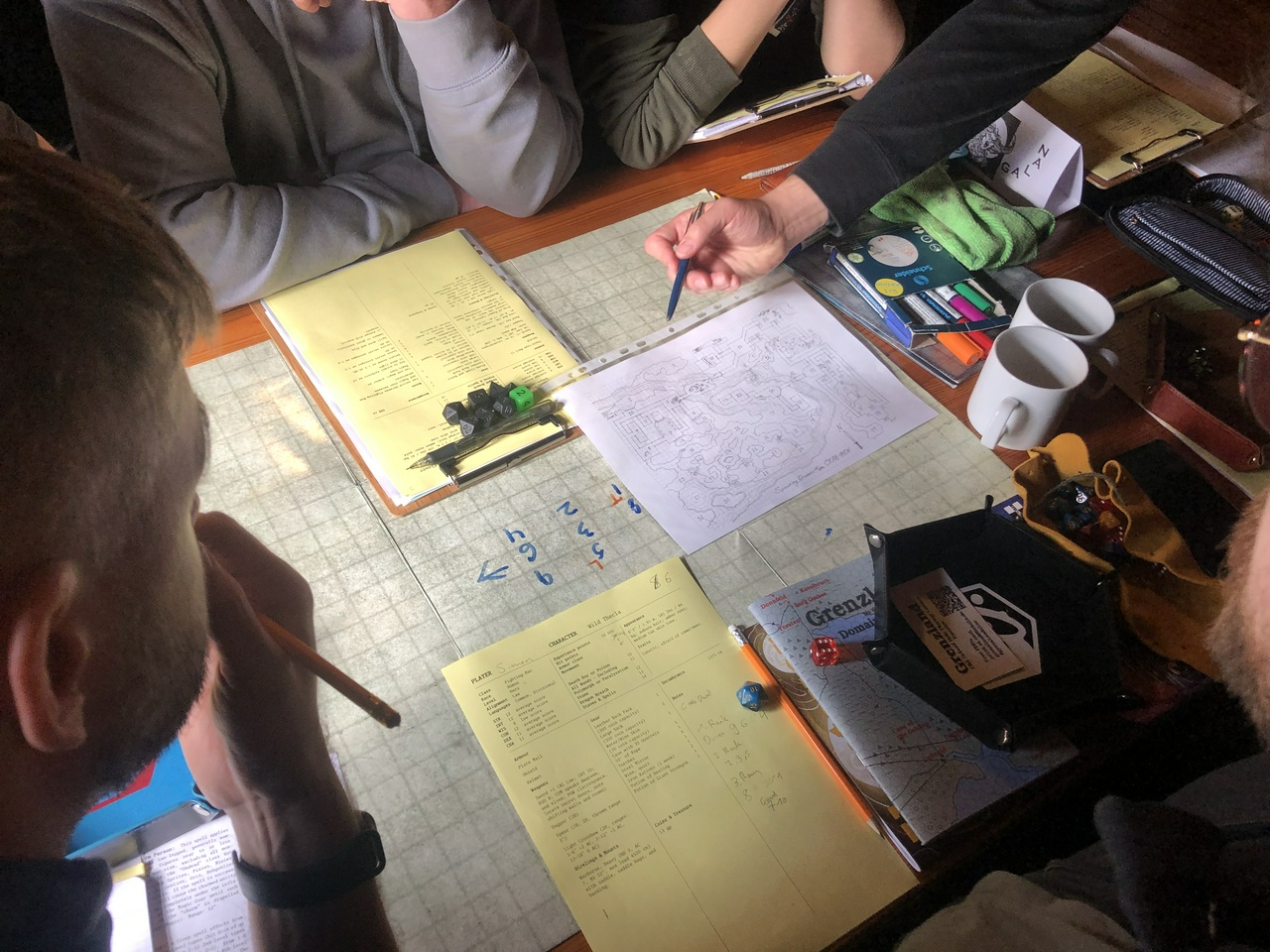 |
| Witness my generosity as I reveal the map. Photo by MK Ultra. |
Sann watched onwards, straining all his muscles to hold onto the dwarf. Their coracle bobbed and rocked as the stream accelerated and reached a fork. The river split around an islet upon which a ruined tower stood. They flowed left. Skorri pulled out a dagger and began cutting of the straps of his armour.
Seeing that nothing is going according the plan, other adventures began singing sailor songs. Everyone—those on land and those in coracles—began pulling on the rope right in front of them. Wiser of the crowd took out sacks to minimise hand burns.
Skorri cut off one shoulder strap just in time to avoid smashing into stone debris of broken bridge. At this moment both Sann and Skorri could hear noise of great waterfall. Sann let go off Skorri, holding him now with only one hand, while using the other to hurl grappling hook onto the islet. Alas! He failed to grab onto anything that would act as a solid anchor point.
The dwarf managed to cut off his second strap and belt. He was almost catapulted backwards as Sann pulled him out. The duo laid wet on their backs in the bobbing coracle, heaving from exhaustion. For a moment they slowed down. Then a snap was heard and they were flying mid air, rushing towards a great underground lake.
Those pulling suddenly found it much easier to pull. Wild Thecla pulled forth nothing but snapped rope. First coracle was lost. But there was no time for weeping! Bresal, still levitating, pointed to the tower at the islet. She put to Sleep three disgusting frog-like creatures. Others paddled to the islet and disembarked.
There were two bridges. One to the east was collapsed and unusable. The one to west was intact and doors behind it were broken open. Judge Theodohilda sent forth her brain-rats to investigate. A dozen or so degenerate cave-men laid in ambush, hiding atop the rubble.
Undeterred, adventurers charged in, funneled through a three feet wide corridor. Cave-men attacked with spears from above, but they were no match to the awesomeness of the party. Gottri barreled in like a wrecking ball. Bresal used her Wand of Fear to scare cave-men within clear line of sight. Elf shoot left and right. Duree was chucking her Hammer of Return, bursting heads left and right.
“Clonk! Clonk! Clonk!” cave-men chanted. Indeed, Vikram was faced off by an ogre-sized abomination, a human-shaped crab with massive left pincer and deformed human-like right arm. Creature wielded a magical shortsword. It clacked with its claw and counter charged the dwarf. With more adventurers pouring it, now it was free for all. Total madness and chaos, a swirling mass of twenty combatants.
Bresal scaled the rubble, just in time to spot four giant crabs attempting to enter through south corridor. Luckily, they were so big they had to enter one by one. She aimed her Wand of Fear down the corridor, and forced three to flee. They tore the fourth one apart for it stood in their way.
Sann laid dazed in the coracle. Skorri looked around the lake. He took the paddle out and moved them towards north cave wall. Then he followed it eastwards. He eventually found a landing in the northeast portion of the cavern. There he saw steps carved sideways into the cave wall. On top were four muscled out SPECI-MEN. Huge, bulging muscles, veins as thick as child's arm, tongues hanging out sideways, crazy hairs. Two were sitting on the ledge, while other two were striking body-builder poses.
Skorri, in nothing but loincloth, reciprocated by striking poses of his own. Suddenly one of the SPECI-MEN lunged forward, jumped, and dive bombed into the lake. Others howled and clapped. Sann, recovering his facilities, clapped, as did Skorri. They waved them up. Second SPECI-MAN rushed forward, slipped on the ledge, and fell straight on his head. His neck snapped. SPECI-MAN sat up, dazed, snapped his neck back, and cried out. Those above him cheered him one. Sann offered to rub his feet with some oil. “It will feel good, I promise.” Skorri looked on in confused horror.
Up close, they could see that SPECI-MEN had talons on both hands and feet. Their jaws were thrice the size of normal men. Their teeth were all sharp, like sharks. They blinked and twitched several times per second. Sann tried to rub the feet of injured SPECI-MAN, but even his feet were muscled and veiny. Two SPECI-MEN on the ledge above invited Skorri to join them. Dwarf obliged, and then accepted to do a jump with them. They lifted him like a baby, ran forwards, and then somersaulted forward. What a spectacular jump it was! What form!
Adventuring duo conversed with SPECI-MEN, learning they crave nothing more than LIQUID JOY. They also offered Sann and Skorri to introduce them to the MAKER who can make them bigger, stronger, and faster. And who makes LIQUID JOY! Desiring even bigger muscles, Skorri accepted and was led to a chute in the ground. He jumped down and was never seen again. Sann on the other hand claimed he know people who have LIQUID JOY.
“They are right up that waterfall, where the little island with broken tower is.”
Upon hearing that, the SPECI-MEN entered overexcitement induced frenzy, grabbed Sann and lifted him like a baby, and charged through corridors. They moved left, left, straight,left, through diagonal corridor, burst open double doors, and jumped over the broken bridge. Alas, they slipped a bit, and rammed the bridge ledge with Sann's head. The fighter was now properly concussed and dazed.
Judge Theodohilda, who was standing on intact bridge, noticed the approaching SPECI-MEN. Confused with their demand of LIQUID JOY, she offered them some red wine. They spat it out in disgust. With little left to do, she used her Staff of Commanding to subdue them.
During this time the battle inside the rubble filled antechamber raged on. Wild Thecla drank Potion of Giant Strength and was using cave-men to kill other cave-men. Gottri duelled Crazy Clonk, delivering blow after blow. Alas, at one moment the dwarf lost his footing, and Crazy Clonk punished him greatly for it. Crab-Man grabbed his sword arm with pincer, nearly severing it in the process. Then it pinned the dwarf with its great bulk, and repeatedly stabbed him with his magical shortsword. The dwarf died a brutal death.
But Crazy Clonk was far from over. He dropped his little short sword, and seized Gottri's Flaming Sword. Now that was a proper magical sword! Cave-men cheered, but not for long, for they were summarily exterminated by enraged adventurers. Bresal turned her attention to Clonk, summoned a Sea-Food Chef via Phantasmal Force, which sent the Crab-Man fleeing in terror. Wild Thecla grabbed him, pried open his shell and then ripped him apart.
There was not time to mourn the fallen. Loud chanting sounds could be heard from the south west corridor. Adventurers rushed forth, charging into the temple filled with Crab Cultists. A dwarf was chained to the alter, funnel forced in his mouth, with a naked man dressed in crab shells pouring some foul concoction down his throat.
Aldoin cast Hold Person, elf shot, fighters charged in. Wild Thecla, now armed with hear magical sword +1 as well as Flaming sword, hacked through the cultists with glee. Others did not fall behind too much. It was a sixty second massacre. They freed the dwarf, and fled back to the islet.
“How do we get back?!”
“I have an idea.” Judge Theodohilda said. She commanded that SPECI-MEN jump in the river, ropes tied to them, and swim upstream. They tied coracle to them. SPECI-MEN found this to be great fun. And so did adventurers save one of their dwarven friends, while leaving another to a fate more horrible than death itself.
Cauldron 2025 Posts
All posts for the Cauldron 2025 convention:
#Convention #Cauldron #OSR #FightOn
Subscribe to get the latest post in your inbox. No spam.
Comments


